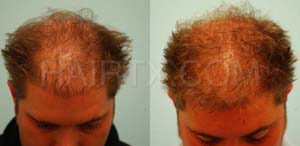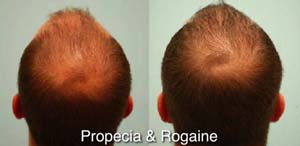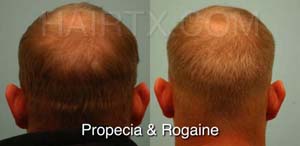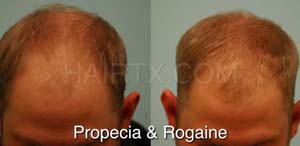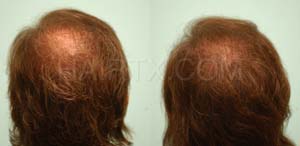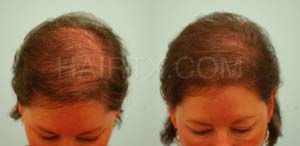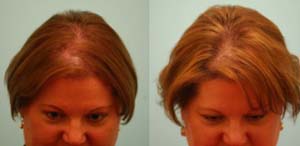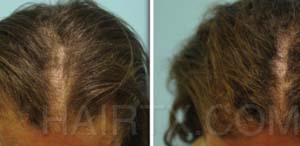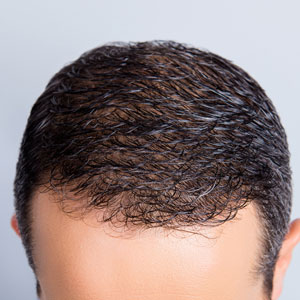Rogaine (Minoxidil)
Hair loss affects nearly 20 percent of women and half of men over the age of 50 in the United States. Genetics, hormonal changes, medical conditions, stress, and aging can all cause hair loss, but it can happen to anyone. Gradually thinning hair on the top of the head, a receding hairline, and patchy bald spots are common symptoms of hair loss that can happen gradually or suddenly. Since hair is commonly associated with attractiveness and vitality, hair loss can be an unwelcome and traumatizing experience. Fortunately, there are proven medical treatments that can help mitigate this condition, including minoxidil, the active ingredient in Rogaine. This FDA-approved treatment for hair loss in men and women can promote regrowth and add thickness and density to the hair.
Minoxidil (Rogaine) is a topical product that helps with hair growth and slows down hair loss. It is acceptable to be used in both men and women and comes packaged in 2% (women) and 5% (men but now approved for women too). The 5% formulation is sold as either a liquid or a foam: both forms have the same efficacy. However, the liquid has a 22% chance of an allergic reaction due to the presence of propylene glycol; whereas the foam has about a 2% chance of allergy. In general, the liquid is less expensive than the foam. It may be worth purchasing both the liquid and the foam initially to see which product is easier to apply and style , and causes less allergic reactions. It is important that the product be placed onto the scalp and no showering or water exposure should be undertaken for 4 hours. Oftentimes hair-growth results can be observed as early as 3 to 4 months after starting. Now, an oral minoxidil regimen can be used as an alternative to topical minoxidil for higher compliance and possible efficacy.
Topical minoxidil, marketed most popularly as Rogaine, has been used for decades for hair loss. However, Dallas hair transplant surgeon Dr. Sam Lam believes that the hair genome test allows the most precise way to dose you based on your genetic sensitivity and resistance to topical minoxidil. For example, approximately 50% of individuals lack sulfotransferase, an enzyme needed to activate minoxidil in the scalp, thereby requiring higher doses for efficacy. Oral minoxidil can also be a suitable alternative for some looking for an easier regimen of compliance.
Contact Us Today! Read Our Manifesto Visit Our Gallery
Key Points
- Ideal candidate
Rogaine is most effective for people who start using it at the first indications of hair loss.
- Male or Female at any stage of hair loss
- Someone whose hair is not growing as long or as dense as in youth
- Someone who has been on other types of medical treatments such laser and is looking for other ways to stimulate hair growth
- Someone with hair shedding who would like to slow down this problem
- Someone who is using it to stabilize their miniaturized hairs for a minimum of 4 to 6 weeks prior to a hair transplant
- What to do
Minoxidil may stimulate and extend the anagen phase of hair growth, encourage blood flow to the folicles, and promotes thicker hair.
- Now, oral minoxidil can be an effective alternative to topical formulations. Please see the dedicated page for more details.
- An effective way to determine how best to dose oral or topical minoxidil, you should consider doing the Hair Genome Test to determine your genetic profile and sensitivity to minoxidil.
- For those who do not take the Hair Genome Test, a standard compounded version of minoxidil, 82M, can be a good start, but Dr. Lam highly recommends the Hair Genome Test for an accurate assessment of the exact dose you need.
- Use it once a day but double the recommended dose on the package insert. It is good to consider if you are a morning or a night person and then do the treatment at the appropriate time. For example, if you are a morning person and you try to apply minoxidil at night, you may be so sleepy you forget most of the times. The converse is true for a night person.
- Apply it on dry scalp and leave it on for several hours to allow the product to penetrate to the hair follicles.
- Wash your hair as normal, according to your schedule, but not for 4 hours after application of minoxidil.
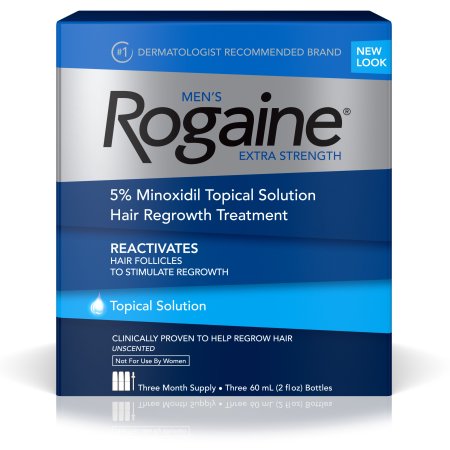 What to expect
What to expect
Rogaine is clinically proven to help stop and reverse hair loss by reactivating dormant hair follicles with varying timelines.
- A few patients usually notice that their hair is thicker and longer after about eight weeks. However, The improvement in hair appearance can be observed as early as 3 to 4 months after starting the treatment. We will take before-and-after photos to monitor your progress.
- The improvement can continue up to 12 months from starting the treatment and thereafter reach a plateau.
- Some patients can experience temporary hair shedding at the beginning of the treatment at around 4 to 6 weeks after starting. This is temporary and should subside. In some way, this initial shedding is a good sign since some of the hairs maybe being pushed into a growth, or anagen, phase.
- Instructions for men’s and women’s Rogaine treatments may also differ because women can be more susceptible to side effects like light-headedness and unwanted hair growth.
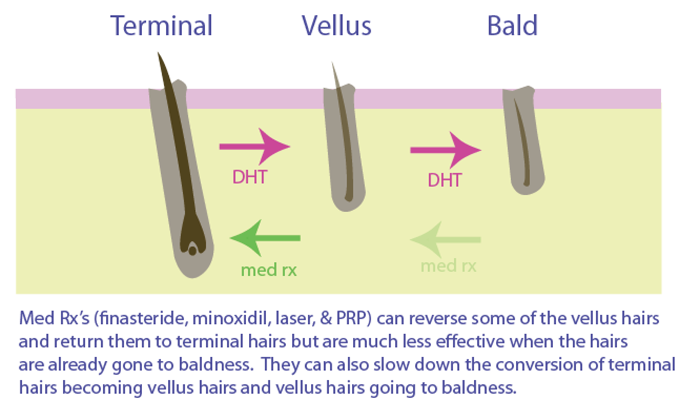
Consult with Dr. Lam
A great way to maximize the benefits of Rogaine is to consult with Dr. Sam Lam, a board-certified dermatologist who specializes in scalp health, before starting any treatment. This way, he can provide guidance and customize treatment to address your specific needs. Contact Lam Institute for Hair Restoration in Plano or Dallas, Texas today to schedule an appointment.
FAQs
-
How does minoxidil work?It is unclear how minoxidil truly works. Some speculate that the medication works to enhance blood flow to the hair follicles. Other experts speculate that as a potassium-channel agonist it helps to regulate hair growth through this pathway. Whatever the mechanism by which minoxidil works, it simply works very well.
-
Do I need a prescription for it?No, unlike finasteride, standard minoxidil is over the counter in the United States. The liquid is cheaper than the foam but has the same efficacy. It is worth buying one bottle of liquid and one bottle of foam to see which is easier to apply based on one’s scalp and hair qualities. The key is the product must be applied directly to the scalp not to the hair itself for it to work. However, you may need a higher concentration of minoxidil, especially if you have taken the Hair Genome Test, or an oral dose, both of which would require a prescription.
-
The package insert says twice a day. Why does Dr. Lam recommend using it only once a day?Most individuals have a hard time complying with using it twice a day. That is why Dr. Lam recommends just once a day. Some reports have shown the benefit to be very similar between a once- and a twice-a-day regimen. If you can easily apply the product twice a day, then do so. As recommended above, do it in the morning if you are a morning person and do it at night if you are a night person. That will help your compliance. The reason that Dr. Lam also recommends doubling the dose that is on the package insert is that the original studies only looked at minoxidilbeing applied to only one area of the scalp, i.e.,the crown. If hair loss is more extensive and encompasses several areas such asthe hairline, temples, temporal points, mid-scalp, crown, etc., he recommends doubling the dose that is recommended on the package insert.
-
I hear that minoxidil does not work in the front but only in the crown region. Is that true?This is false. The reason why the package insert only states the efficacy in the crown is that initial FDA trials only evaluated the crown, so the package insert has to reflect the parameters of those clinical trials. Nevertheless, subsequent to those trials, studies have shown that minoxidil works very well in the front and the back of the scalp.
-
As a woman, should I use the 2% or the 5% dose?Both 2% and 5% are FDA-cleared for women. 5% once a day is what Dr. Lam recommends for women to start with because he believes that it can yield better outcomes. Of note, unlike for men, the 5% dose is only meant for once a day for women. The 2% is meant for a twice-a-day application. The major side effect for women is secondary hair growth that can occur on the face. If this occurs, it is not due to spillage of the product but the fact that the concentration is too high for you and may have promoted hair growth in other parts of your body. If that occurs, then switch to 2% twice a day and if that persists then you can go to 2% once a day. Also, for women, Dr. Lam has found that a steroid component mixed with the minoxidil may help with hair growth better than regular minoxidil by itself. There has been documented evidence that female hair loss may be inflammatory in nature, so the steroid component tapered to a lower dose after 6 months may be beneficial. Because the product is compounded by a pharmacy, Dr. Lam does need to give you a prescription for it.
-
I think this is a real hassle and I won’t be compliant. What should I do?Compliance is everything. If you are not compliant, then you won’t gain any benefit. Dr. Lam advocates a once-a-day treatment. This alone has helped many more patients be compliant. He believes that a morning person should take it in the morning and a night person should do so at night before going to bed. Also, changing one’s frame of mind can be helpful. Think that the application of minoxidil only takes about 5 seconds a day. It will take you longer to brush your teeth and if you are already there in the bathroom consider adding minoxidil to your daily bathroom hygiene regimen. Also, like exercise and diet, it is not all or none. In other words, if you skipped exercise for a week or two and stopped eating well for a while, shouldn’t you try to return to a healthier lifestyle? The same should apply to minoxidil. If you skip a day or so, just simply restart. If you were on vacation for a week and forgot your minoxidil, simply restart when you return home. However, if you stop minoxidil for 3 to 4 months, then you really would have lost a lot of what you have held onto for so many months or years that you were on it, so try to be as compliant as possible. Even if you had stopped for 3 to 4 months, still consider restarting minoxidil.
-
What if I stop using minoxidil? What will happen?In short, you will have lost what you gained or retained during the time you were on it.Unfortunately, all of the hair that is preserved during the time you are on minoxidil will be lost over 3 to 6 months after stopping the application. To clarify, if you have been on the minoxidilfor 5 years and then stop, the amount of hair that was preserved during that time will be lost (not more hair than you would have lost). This can be very discouraging to hear but with such an effective medication available, Dr. Lam likes to help your psychology by saying: “Keep taking minoxidil for as long as you care that you have hair or until a better medication comes around.” Of note, there are so many technological breakthroughs that are on their way like prostaglandin modulators (both topical and oral), DNA 3D printing of follicles, etc. However, if you don’t start taking minoxidil and wait until these medications arrive on the market you may have irreversibly lost so much hair thatminoxidil or another medication will be far less effective. Accordingly, you should start your minoxidilas soon as you can and be as compliant as you can.
-
Do I need finasteride, PRP, etc., or other medical therapies if I am on minoxidil?In short, yes, if possible. Minoxidil works synergistically (or additively) with finasteride (which to be clear is only for men). Someone who has been on finasteride for a long time and then adds minoxidil should see an uptick in improvement. Conversely, someone who has been on both finasteride and minoxidil and who stops one or the other product will notice a similar worsening. As many therapies (finasteride, minoxidil, laser, and PRP injections) that you can afford, tolerate, and desire, you should consider because all of these methods are additive in their benefits. Dr. Lam will help consult with you on the pros and cons of all the treatments to help you decide which combination may be ideal for you.
-
Minoxidil didn’t work for me. Should I truly try again?Minoxidil is highly effective in almost every single person taking it. The reason why minoxidil may have seemed to fail may be for the following reasons: 1) unrealistic expectations where you believed that the medication would be as good as a hair transplant (which it is not) 2) progressive rapid hair loss that exceeded what minoxidil could offset, and 3) not using it long enough to see its benefits (it takes 4 to 6 months before experiencing visible growth). In general, Dr. Lam believes that minoxidil is highly effective in almost every person who takes it, so he recommends it to the majority of patients with progressive hair loss. Nevertheless, he will tailor his thoughts based on your exact clinical issues during a consultation.
-
Should I buy generic or brand name?Unlike for finasteride, Dr. Lam does not believe that generic is necessarily less ideal than brand name for minoxidil.
-
Why does Dr. Lam want me to use minoxidil only around the time of surgery?Even for someone who simply does not want to use minoxidil long term, Dr. Lam oftentimes recommends minoxidil around the time of the procedure, preferably at least a month if not longer before a planned hair-transplant surgery in patients with miniaturization and especially in women because of the higher risk of temporary shedding postoperatively. Minoxidil can stabilize the weaker (vellus) hairs that may be prone to temporarily shed after surgery, so Dr. Lam uses minoxidil to help minimize this risk. Minoxidil should be stopped 2 days prior to surgery and resumed 7 days afterward. For those who are not going to use minoxidil long term but only for the above-stated reasons, Dr. Lam would recommend continuing it once a day for 6 to 12 weeks following the procedure if possible. The key, however, is to have used it before the procedure. Further, oftentimes, if you have been compliant with using minoxidil for 6 to 8 weeks already, you may form a new habit and see that doing so is pretty easy to continue.
-
Will I need minoxidil if I am still planning to have hairtransplant surgery?Possibly. The first reason to have minoxidil even though you are planning to have hair-transplant surgery is stated above to reduce the risk of shedding after a procedure. The second reason is also stated in this section, which is to help with further hair loss that may occur as one continues to age. Dr. Lam will discuss with you the pros and cons of short- and long-term use of minoxidil as it relates to your situation during a consultation.
-
Are there any side effects?In some cases, minoxidil can cause scalp irritation, headaches, and/or facial hair growth. Women who are pregnant or breastfeeding should not use minoxidil and women who are trying to get pregnant should stop using minoxidil.
Videos
Photos
For more Rogaine (Minoxidil) Before & After Photos, Click here

